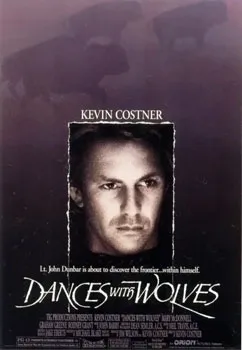Historical accuracy of Dances with Wolves

Historical accuracy of Dances with Wolves

Characters
Lt. John Dunbar / Dances With Wolves (K. Costner)
Entirely fictional protagonist. While a real missionary named John Dunbar worked with the Pawnee earlier in the 19th century, there is no connection to the film's character or story.
Stands With A Fist (Mary McDonnell)
Fictional character, although her backstory was inspired by the real historical figure Cynthia Ann Parker, a white woman captured as a child and raised by the Comanche (not Lakota Sioux).
Kicking Bird (Graham Greene)
A fictional character representing a spiritual leader and wise elder within the Lakota band.
Wind In His Hair (Rodney A. Grant)
A fictional character representing the warrior element of Lakota society, initially distrustful but later respectful of Dunbar.
Chief Ten Bears (Floyd Red Crow Westerman)
A fictional character representing tribal leadership. A historical Comanche chief shared the name, but the film character is Lakota and fictionalized.
Timmons (Robert Pastorelli)
Fictional character providing transportation and exposition early in the film.
More characters
Major Fambrough (Maury Chaykin)
Fictional character whose mental state facilitates Dunbar's isolated posting.
Lt. Elgin (Charles Rocket)
Fictional character representing the returning U.S. Army presence and conflict with Dunbar.
Pawnee warriors (incl. Wes Studi)
Represents the historical Pawnee tribe, who were traditional enemies of the Lakota Sioux. Their portrayal as uniformly aggressive antagonists has been criticized by some as one-dimensional or stereotypical.
Two Socks (the wolf)
Fictional element symbolizing Dunbar's connection to the wild/wilderness.
Story
Dunbar's transfer to frontier post (Fort Sedgwick)
Dunbar and his specific posting are fictional. Fort Sedgwick was real (in CO/NE area) but established slightly later (1864); its depiction as abandoned reflects plausible issues but is part of the fictional setup.
Gradual acceptance and cultural exchange with Lakota
While the specific story is fictional, the film portrays a process of cross-cultural communication and understanding with sensitivity, considered groundbreaking for its time.
Depiction of Lakota Sioux culture (1860s)
Generally praised for its attempt at authentic portrayal of Lakota daily life, social structure, spirituality, council meetings, and reliance on the buffalo, developed with Lakota consultants.
Use of Lakota language
Extensive use of subtitled Lakota was revolutionary. However, linguists noted inaccuracies, primarily the failure to use gendered language forms, making male characters sound female to native speakers.
The Buffalo Hunt
Accurately portrays the central importance of the buffalo hunt to Plains tribes' survival and culture, depicting it as a communal effort. (Used a large managed herd and animatronics).
Wasteful slaughter of buffalo by white hunters
The scene depicting buffalo carcasses left to rot after being skinned by white hunters accurately reflects the historical mass slaughter that decimated the herds and Plains Indian life.
Conflict between Lakota Sioux and Pawnee
The Lakota and Pawnee were historical enemies and frequently raided each other. The film accurately depicts this intertribal conflict, though primarily from the Lakota perspective.
Dunbar choosing to live with the Lakota ("Going Native")
Dunbar's complete assimilation and choice to abandon his former life is part of his fictional character arc.
U.S. Army hostility towards Dunbar as "traitor"
Accurately reflects the likely historical reality that a soldier abandoning his post and siding with Native Americans would be viewed as a deserter or traitor by the U.S. military.
Dunbar leaving Lakota to protect them
The specific reason for Dunbar's departure at the film's end is part of his fictional narrative.
Dunbar's initial "suicide run" in battle
The opening Civil War scene establishing Dunbar's character and transfer request is fictional.
Setting
Great Plains Landscape (Dakotas, 1860s)
Filmed on location in South Dakota and Wyoming, the movie beautifully captures the vast, open prairie landscapes central to the story and Plains Native life.
Lakota Sioux Encampment
Tipis, village layout, and depiction of daily life within the camp appear authentic and were developed with input from Lakota cultural advisors.
U.S. Army Frontier Post (Fort Sedgwick)
The depiction of the isolated, rudimentary, and ultimately abandoned fort reflects the often precarious nature of military outposts on the mid-19th century frontier.
Costumes (Lakota and U.S. Army)
Generally praised for accuracy in depicting Lakota attire (buckskins, beadwork, specific items like Stands With A Fist's elk-tooth dress) and Union Army uniforms of the 1860s.
Weaponry and Equipment
Firearms (Union rifles, revolvers) and Native weaponry (bows, lances, shields) shown are appropriate for the Civil War era on the Plains.
Depiction of Wildlife (Buffalo, Wolves)
Integrates key plains wildlife central to the ecosystem and Native culture, emphasizing the connection between the people and the natural world.
Atmosphere of Cultural Encounter/Clash
Successfully conveys both the potential for understanding between cultures and the looming threat of conflict and displacement due to westward expansion.
Overall Period Feel (1860s Frontier)
Despite fictional elements, the film is lauded for its immersive and largely authentic recreation of the look and feel of the American frontier during the Civil War era.
